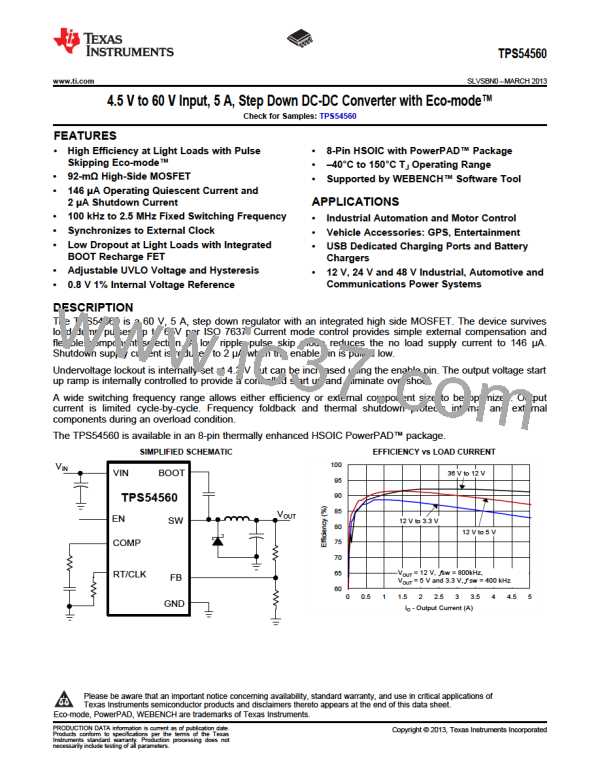TPS54560
SLVSBN0 –MARCH 2013
www.ti.com
The most stringent criteria for the output capacitor is 62.5 μF required to maintain the output voltage within
regulation tolerance during a load transient.
Capacitance de-ratings for aging, temperature and dc bias increases this minimum value. For this example, 3 x
47 μF, 10 V ceramic capacitors with 5 mΩ of ESR will be used. The derated capacitance is 87.4 µF, well above
the minimum required capacitance of 62.5 µF.
Capacitors are generally rated for a maximum ripple current that can be filtered without degrading capacitor
reliability. Some capacitor data sheets specify the Root Mean Square (RMS) value of the maximum ripple
current. Equation 34 can be used to calculate the RMS ripple current that the output capacitor must support. For
this example, Equation 34 yields 459 mA.
2´ DI
2 ´ 2.5 A
OUT
C
>
=
= 62.5 mF
OUT
f
´ DV
400 kHz x 0.2 V
SW
OUT
(30)
2
(OH ) (OL )
2
3.75 A2 -1.25 A2
I
-
I
(
)
(
)
= 44.1 mF
COUT > LO
x
= 7.2 mH x
2
2
5.2 V2 - 5 V2
V
-
V
I
( ) ( )
(
)
f
(
)
(31)
1
1
1
1
C
>
´
=
x
= 19.9 mF
OUT
8´ f
8 x 400 kHz
25 mV
1.591 A
æ
ç
è
ö
÷
ø
æ
ö
V
SW
ORIPPLE
ç
è
÷
ø
I
RIPPLE
25 mV
1.591 A
(32)
(33)
V
ORIPPLE
R
<
=
= 15.7 mW
ESR
I
RIPPLE
V
´ V
(
IN max
(
- V
OUT
OUT
)
=
IN max
(
5 V ´ 60 V - 5 V
)
(
)
12 ´ 60 V ´ 7.2 mH ´ 400 kHz
I
=
= 459 mA
COUT(rms)
12 ´ V
´L ´ f
O
SW
)
(34)
Catch Diode
The TPS54560 requires an external catch diode between the SW pin and GND. The selected diode must have a
reverse voltage rating equal to or greater than VIN(max). The peak current rating of the diode must be greater than
the maximum inductor current. Schottky diodes are typically a good choice for the catch diode due to their low
forward voltage. The lower the forward voltage of the diode, the higher the efficiency of the regulator.
Typically, diodes with higher voltage and current ratings have higher forward voltages. A diode with a minimum of
60 V reverse voltage is preferred to allow input voltage transients up to the rated voltage of the TPS54560.
For the example design, the B560C-13-F Schottky diode is selected for its lower forward voltage and good
thermal characteristics compared to smaller devices. The typical forward voltage of the B560C-13-F is 0.70 volts
at 5 A.
The diode must also be selected with an appropriate power rating. The diode conducts the output current during
the off-time of the internal power switch. The off-time of the internal switch is a function of the maximum input
voltage, the output voltage, and the switching frequency. The output current during the off-time is multiplied by
the forward voltage of the diode to calculate the instantaneous conduction losses of the diode. At higher
switching frequencies, the ac losses of the diode need to be taken into account. The ac losses of the diode are
due to the charging and discharging of the junction capacitance and reverse recovery charge. Equation 35 is
used to calculate the total power dissipation, including conduction losses and ac losses of the diode.
The B560C-13-F diode has a junction capacitance of 300 pF. Using Equation 35, the total loss in the diode at the
maximum input voltage is 3.43 Watts.
If the power supply spends a significant amount of time at light load currents or in sleep mode, consider using a
diode which has a low leakage current and slightly higher forward voltage drop.
24
Submit Documentation Feedback
Copyright © 2013, Texas Instruments Incorporated
Product Folder Links: TPS54560

 TI [ TEXAS INSTRUMENTS ]
TI [ TEXAS INSTRUMENTS ]